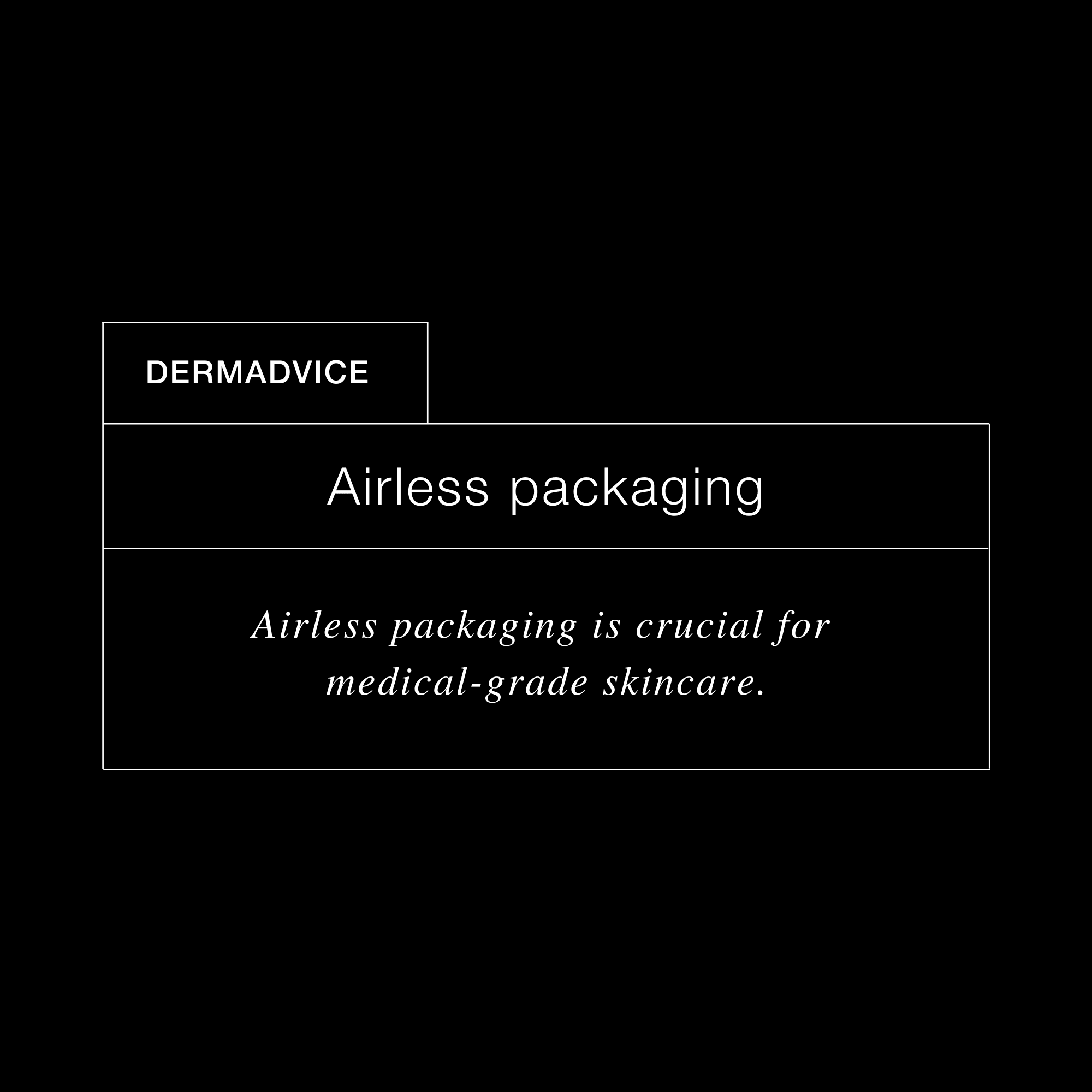Why do you need a facial cleanser with a low pH?
Cleansers do not stay on your skin long enough to reach deeper layers, but they play a critical role in your daily skincare routine. Most obviously, they clean your skin of dirt, excess oil, makeup, and other debris that could otherwise become trapped inside your pores and cause all sorts of skincare woes, including acne.
However, many do not know that cleansers play an equally important role. The right facial cleanser can slightly lower your skin's pH, which has numerous benefits.

pH stands for "power of hydrogen" and measures the acidity vs. alkalinity of a solution of water + something. pH 7 is the neutral point. Anything below it is an "acid," and anything above it is a "base" (or alkaline).
The pH of your skin's protective barrier (acid mantle) is around 4.7. This sits slightly on the acidic side of the pH scale, which runs from 0 to 14, with zero being highly acidic and 14 highly alkaline. Water is considered neutral, falling directly in the middle of the scale at 7.
This protective barrier has two essential functions:
- It keeps water in your skin so that it stays soft and hydrated
- It keeps germs, bacteria, and pollutants out of the skin, preventing inflammation, infections, and irritation.
When your acid mantle is intact, your skin is moisturized and healthy. But when it starts to crack, your skin becomes dry and sensitive and more prone to irritations, inflammation, acne, and aging.
So you just need to make sure it stays intact, right? It's not so easy. Anything you put on your skin has its own pH, which affects the pH of your skin. What you use on your face can destroy this protective barrier. Cleansing is one of the biggest culprits.


Cleansing changes the pH of your skin. Even normal tap water alone is enough to do the trick. A 1999 study compared the cleansing powers of tap water, liquid soaps, and bar soaps and found that:
"Each cleansing agent, even normal tap water, influences the skin surface. The increase of the skin pH irritates the physiological protective 'acid mantle,' changes the composition of the cutaneous bacterial flora and the activity of enzymes in the upper epidermis, which have an acid pH optimum."


- Moisture evaporates, drying out the skin
- Skin feels tight
- Skin can't protect itself from the environment and becomes more sensitive
- Germs and pollutants get in, irritating the skin
- Bacteria proliferate, causing inflammation, sensitivity, and acne


There's a reason why your skin's acid mantle is acidic. An acidic pH is NOT bacteria-friendly. But when you raise the pH several notches, bacteria suddenly find the perfect environment to increase and thrive.
A 1995 study tested the impact of cleansing on acne-prone skin. Scientists asked patients with inflammatory acne lesions to use either soap or an acidic cleanser for three months. The results? Only one month later, the group using soap had way more lesions than before, while the group using an acidic cleanser had the opposite result: fewer lesions than before!
High pH soaps make acne worse, while acidic cleansers help clear acne up.
The reason? As this study shows, when you wash your face with soap, C. Acnes (the new name for the bacteria that causes acne) increases. You have a lot of those nasty buggers on your skin. But when you switch to an acidic cleanser, the amount of C. Acnes bacteria on your skin falls significantly.
In other words, an acidic cleanser makes your skin inhospitable to C. Acnes and other bacteria. So, if you wash your face often with the wrong type of cleanser (harshly loaded with surfactants and usually foaming) in the hope of getting rid of shine and pimples, you're only making things worse.
Foaming cleansers are usually the worst culprits because they use surfactants (ingredients that help water mix with oil and dirt so they can be rinsed away) that raise the skin's pH.
You've probably heard that your skin's pH eventually returns to normal after cleansing. That's true. But it takes its sweet time to do so—more than 90 minutes, sometimes. In the meantime, your skin will be overly oily or overly dry.
And that's just the short-term effects. Studies show that washing your face with a high-pH cleanser regularly (and you do wash your face every day, don't you?) has a cumulative effect and increases the time your skin takes to recover.
You may have noticed this firsthand, especially in winter. The more you wash your hands (or face, for that matter), the drier they get. The same goes for your skin. That tight feeling you get after washing is a tell-tale sign that your acid mantle is compromised.
This may also be why the rest of your skincare routine isn't working anymore. If you're using hyaluronic acid serums, hydrators, etc., and your dry skin isn't getting any better, chances are your cleansing habits have badly disrupted your acid mantle. Until you fix that, your skin will never go back to normal.


Using a cleanser formulated for your unique Dermal Diagnosis, which slightly lowers your skin's pH can do three important things:
- Increases the effectiveness of other skincare ingredients in your regimen.
- Loosens the "glue" that holds skin cells together.
- It makes your skin less hospitable for acne-causing bacteria.
A lower pH helps to remove the "glue" that binds skin cells together. This sheds old cells from the surface so that fresh new ones can take their place, resulting in younger and healthier-looking skin!
Finally, Cutibacterium acnes (the new name of acne-causing bacteria) cannot thrive in low-pH environments. So, using a cleanser that lowers your skin's pH can also help keep acne at bay by minimizing bacteria.


Alpha hydroxy acids (e.g., Glycolic acid) cleanser lowers the skin's pH and, therefore, helps exfoliate and rejuvenate the skin. Renewal Facial cleanser contains Glycolic acid at the optimal pH. Depending on your skin type, you may have to slowly introduce a glycolic acid cleanser to your regimen, using it only a few times weekly to start.
Some sensitive skin types—such as those who struggle with acne, rosacea, and stinging/burning—may not tolerate Glycolic acid well. Instead, look for other low-pH cleansers that meet the unique needs of your dermal diagnosis. For example, use a Pore Control cleanser that contains Salicylic acid or a Medi-Zinc cleanser that contains Zinc Pyrithione.
BOTTOM LINE
The pH of your cleanser matters. Choose acidic cleansers that don't compromise your skin's acid mantle, and watch your skin say goodbye to dryness, sensitivity, and pimples.
Each product in your Dermal Diagnosis treatment plan has a specific purpose. Using the right cleanser preps your skin for the ingredients that follow while also gently sweeping away dirt and debris.
Wishing you great and healthy skin!
DermExcel Low pH Cleansers
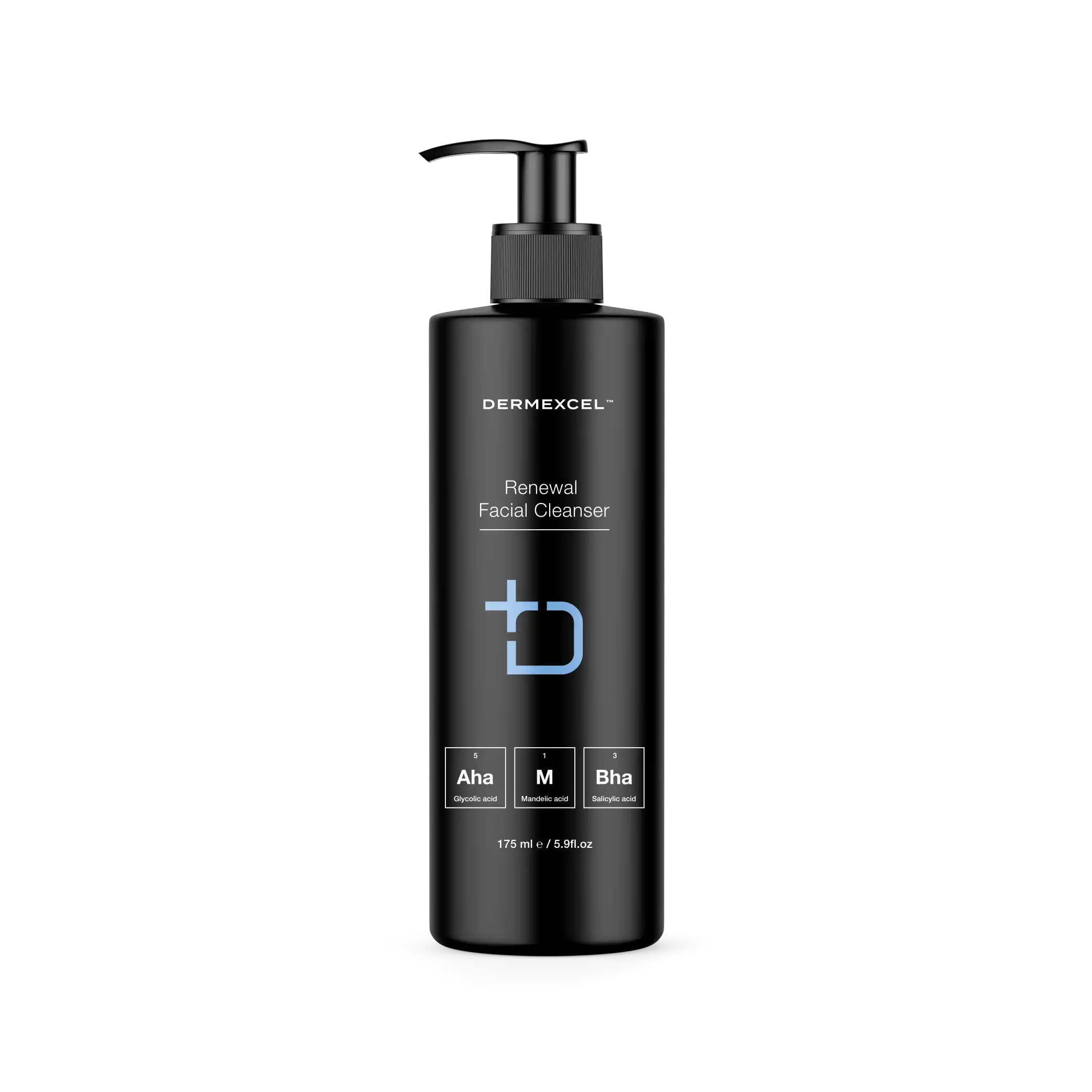
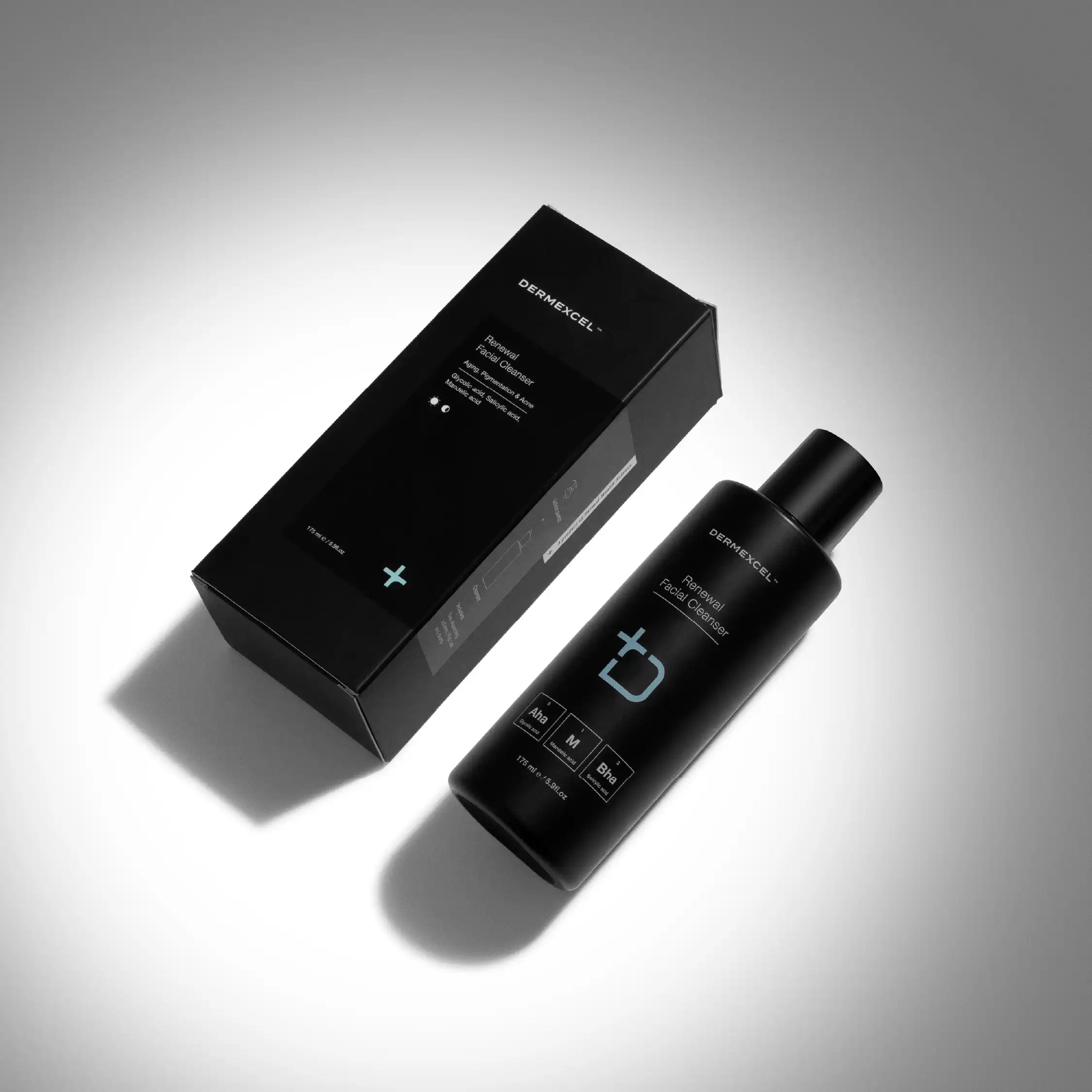
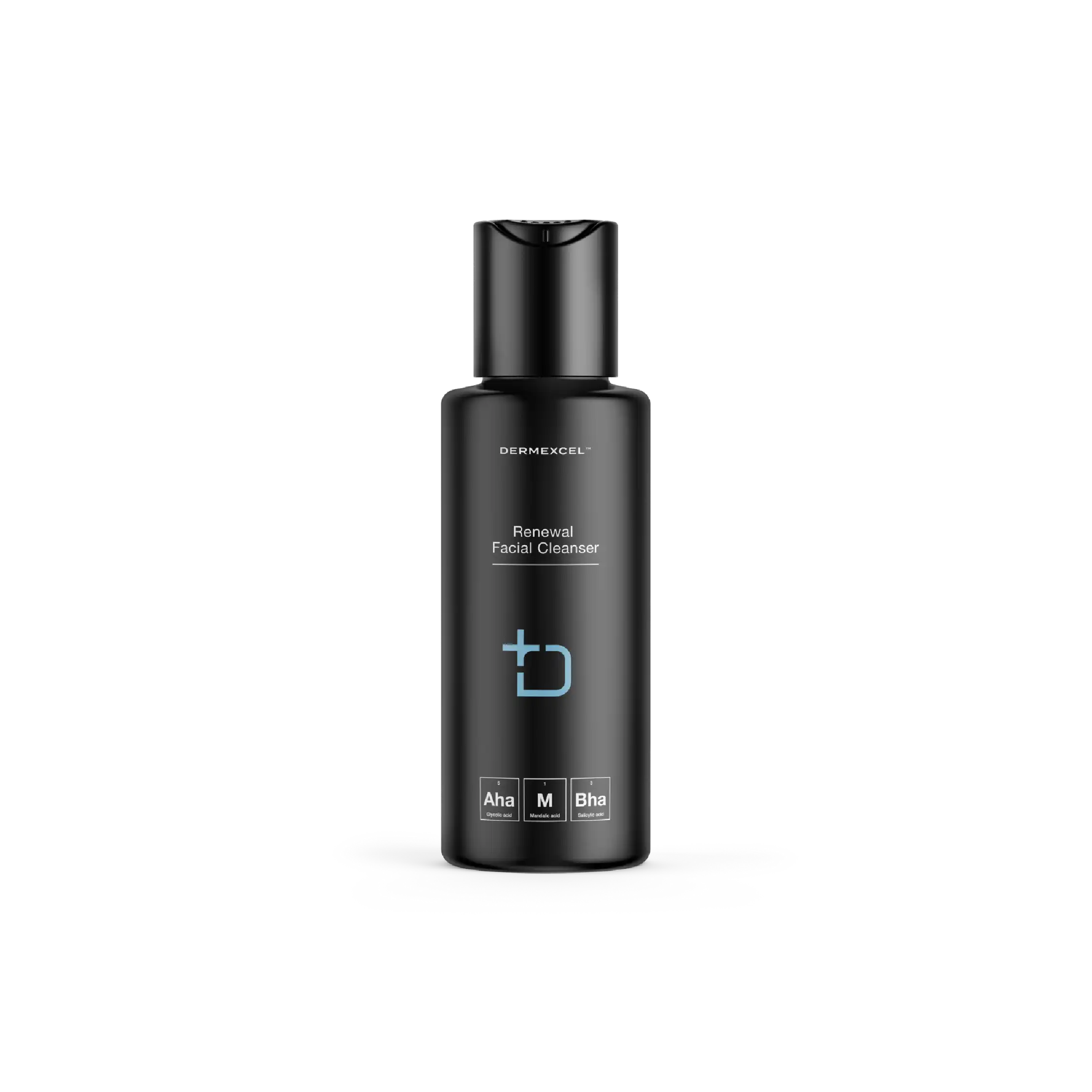





Unclog Pores

Minimize Pores

anti-aging

smooth skin

Brightening
This scientifically formulated treatment cleanser combats the detrimental effects of airborne bacteria and urban pollution on the skin. It leverages a potent blend of active ingredients to address skin aging, pigmentation, and inflammatory conditions.
Renewal Facial Cleanser stands apart with its ability to address multiple skin concerns simultaneously. With its scientifically backed formulation and carefully selected active ingredients, this cleanser offers an effective solution for those seeking to defend against environmental stressors and rejuvenate their skin.
Glycolic acid
Glycolic acid is highly acclaimed for its remarkable exfoliating and rejuvenating properties. Its small molecular size enables deep skin penetration, fostering efficient exfoliation at the cellular level.
Glycolic acid’s water solubility allows it to penetrate the upper layers of the skin easily. Its primary mechanism of action involves weakening the bonds between dead skin cells, promoting their shedding, and revealing the newer, healthier skin beneath. This process of accelerated cell turnover is instrumental in addressing a range of skin concerns, from aging signs like fine lines and wrinkles to texture irregularities and hyperpigmentation.
Glycolic acid's efficacy extends beyond mere exfoliation. It's also recognized for stimulating collagen production, a crucial protein in maintaining skin's elasticity and firmness. This aspect contributes to its anti-aging benefits. Furthermore, its hydrating properties add to its appeal, as they help increase the skin's capacity to retain moisture, leading to a more supple and vibrant complexion.
Clinical studies have consistently supported glycolic acid's role in improving skin appearance. Research indicates significant improvements in skin texture and pigmentation and the visible reduction of wrinkles and fine lines with glycolic acid.
Physiological Effects
- Exfoliation: Glycolic acid is a powerful exfoliant. It dissolves the bonds between dead skin cells on the skin’s surface, facilitating their removal and revealing newer, healthier skin underneath.
- Increased Collagen Production: It stimulates collagen production, essential for skin elasticity and firmness. This action helps reduce the appearance of fine lines and wrinkles.
- Enhanced Skin Hydration: Glycolic acid improves the skin's ability to retain moisture, enhancing hydration and a more plump, vibrant skin appearance.
- Skin Brightening: Removing dead skin cells can brighten the complexion and reduce the appearance of dark spots and hyperpigmentation.
- Improved Skin Texture: Regular use of glycolic acid can lead to smoother, more even textured skin, making it beneficial for conditions like keratosis pilaris.
- Acne Treatment: Its exfoliating properties help in unclogging pores, thereby reducing the occurrence of acne breakouts.
Managing Dermatological Conditions
- Aging Skin: Glycolic acid is widely used in anti-aging products to reduce signs of aging, such as fine lines, wrinkles, and age spots.
- Acne-Prone Skin: It helps manage acne by exfoliating the skin and removing blockage from pores.
- Hyperpigmentation: It effectively treats hyperpigmentation by accelerating the removal of hyperpigmented skin cells.
- Textural Irregularities: Glycolic acid improves skin texture, treating keratosis pilaris and other rough skin conditions.
- Sun-Damaged Skin: It helps rejuvenate sun-damaged skin by accelerating cell turnover and collagen synthesis.
References
- Bernstein, E. F. (2001). Glycolic acid treatment increases type I collagen mRNA and hyaluronic acid content of human skin. Dermatologic Surgery.
- Kornhauser, A., Coelho, S. G., & Hearing, V. J. (2010). Applications of hydroxy acids: classification, mechanisms, and photoactivity. Clinical, Cosmetic and Investigational Dermatology.
- Sharad, J. (2013). Glycolic acid peel therapy – a current review. Clinical, Cosmetic and Investigational Dermatology.
- Smith, W. P. (1996). Epidermal and dermal effects of topical lactic acid. Journal of the American Academy of Dermatology, 35(3), 388-391.
Mandelic acid
Despite its gentler nature, mandelic acid potently accelerates cell turnover, removes dead skin cells, and promotes a fresher, more rejuvenated skin appearance.
Mandelic acid's efficacy extends to a wide range of skin concerns. It's particularly beneficial in treating acne, as its antibacterial properties are effective against various strains of bacteria commonly associated with acne development. Moreover, it's known for regulating sebum production and reducing inflammation, further contributing to its acne-fighting capabilities.
Additionally, mandelic acid has shown promise in addressing hyperpigmentation. Its ability to inhibit melanin production helps reduce age spots, sun spots, and uneven skin tones, making it a valuable ingredient in skincare products targeting pigmentation issues. Studies have documented its effectiveness in improving skin texture and reducing the appearance of fine lines and wrinkles, offering a multifaceted approach to skin rejuvenation.
Physiological Effects
- Exfoliation: Mandelic acid gently exfoliates the skin by loosening the bonds between dead skin cells on the surface, promoting their removal and revealing fresh, new skin underneath.
- Antibacterial Properties: It possesses antibacterial properties, making it effective against acne-causing bacteria.
- Reducing Hyperpigmentation: Mandelic acid is known for its ability to reduce hyperpigmentation, including age spots, sun spots, and marks left by acne, due to its ability to inhibit melanin production.
- Anti-aging Effects: It stimulates collagen production, which can help reduce the appearance of fine lines and wrinkles and improve the overall texture of aging skin.
- Suitability for Sensitive Skin: Due to its larger molecular size than other AHAs, mandelic acid penetrates the skin more slowly and is less likely to irritate, making it suitable for sensitive skin types.
Managing Dermatological Conditions
- Acne Treatment: Its exfoliating and antibacterial properties make mandelic acid effective in treating acne, particularly in those with sensitive skin.
- Melasma and Hyperpigmentation: It is beneficial in treating melasma and other forms of hyperpigmentation, lightening dark spots without causing significant irritation.
- Aging Skin: Mandelic acid is used in anti-aging skin care products to improve skin texture and diminish signs of aging.
- Photo-Aging: It can help to reverse some of the damage caused by UV radiation, such as fine lines and uneven skin tone.
References
- Briden, M. E. (2004). Noninvasive treatments of acne. In Acne and its Therapy (pp. 341-357). Marcel Dekker.
- Taylor, M. B. (1999). Summary of mandelic acid for the improvement of skin conditions. Cosmetic Dermatology.
- Sharad, J. (2013). Glycolic acid peel therapy – a current review. Clinical, Cosmetic and Investigational Dermatology.
Salicylic acid
Salicylic acid, a renowned beta hydroxy acid (BHA), is a cornerstone in dermatology and skincare due to its exceptional keratolytic and comedolytic properties. Its unique ability to penetrate oil-laden hair follicle pores makes it particularly effective in treating acne-prone and oily skin types.
Salicylic acid dissolves skin debris (sebum and dead skin cells) that clogs pores and causes acne. It's a mild antibacterial and powerful anti-inflammatory agent that helps reduce the redness and swelling associated with breakouts.
What sets salicylic acid apart in dermatological treatments is its ability to exfoliate the skin, not just on the surface but within the pores themselves. This is due to its oil-soluble nature, which allows it to penetrate deep into the pores and dissolve the keratin plugs that lead to blackheads and whiteheads.
Furthermore, salicylic acid also has the capacity to adjust the pH of the skin, creating an environment less favorable for the growth of acne-causing bacteria. Salicylic acid's efficacy in treating various skin conditions, particularly acne, has been extensively documented in the scientific literature. Studies have consistently shown its ability to reduce acne lesions in terms of count and severity. Additionally, salicylic acid is highly recommended for its effectiveness in treating other skin conditions, such as psoriasis and dandruff, due to its ability to soften and remove scales and flakes from the skin.
Physiological Effects
- Keratolytic Action: Salicylic acid is known for its ability to exfoliate the skin by dissolving the intercellular 'glue' that holds skin cells together, helping to remove dead skin cells and unclog pores.
- Comedolytic Effect: It is particularly effective in reducing comedones (blackheads and whiteheads) by unclogging pores and preventing the formation of new comedones.
- Anti-inflammatory Properties: Salicylic acid reduces inflammation, which is beneficial in treating acne and other inflammatory skin conditions.
- Sebum Regulation: It helps to regulate oil production, making it a valuable ingredient for managing oily and acne-prone skin.
- Penetration Enhancement: Due to its lipophilic nature, it can penetrate sebum-filled follicles, effectively treating acne located deep within the pores.
Managing Dermatological Conditions
- Acne Vulgaris: Salicylic acid is a cornerstone in acne treatment, effectively preventing and treating existing acne lesions.
- Psoriasis: Its keratolytic properties make it helpful in softening and removing scales associated with psoriasis.
- Warts: Salicylic acid is commonly used to treat warts because it can exfoliate and remove thick skin.
- Seborrheic Dermatitis: It helps manage seborrheic dermatitis by reducing scaling and redness.
- Keratosis Pilaris: Salicylic acid can aid in smoothing the rough bumps associated with peratosis Pilaris.
References
- Zaenglein, A. L., Pathy, A. L., Schlosser, B. J., Alikhan, A., Baldwin, H. E., Berson, D. S., & Thiboutot, D. M. (2016). Guidelines of care for the management of acne vulgaris. Journal of the American Academy of Dermatology, 74(5), 945-973.e33.
- Kornhauser, A., Coelho, S. G., & Hearing, V. J. (2010). Applications of hydroxy acids: classification, mechanisms, and photoactivity. Clinical, cosmetic and investigational dermatology, 3, 135.
- Zander, E., & Weisman, S. (1992). Treatment of acne vulgaris with salicylic acid pads. Clinical Therapeutics.
- Gupta, A. K., & Nicol, K. (2004). The use of sulfur in dermatology. Journal of Drugs in Dermatology.
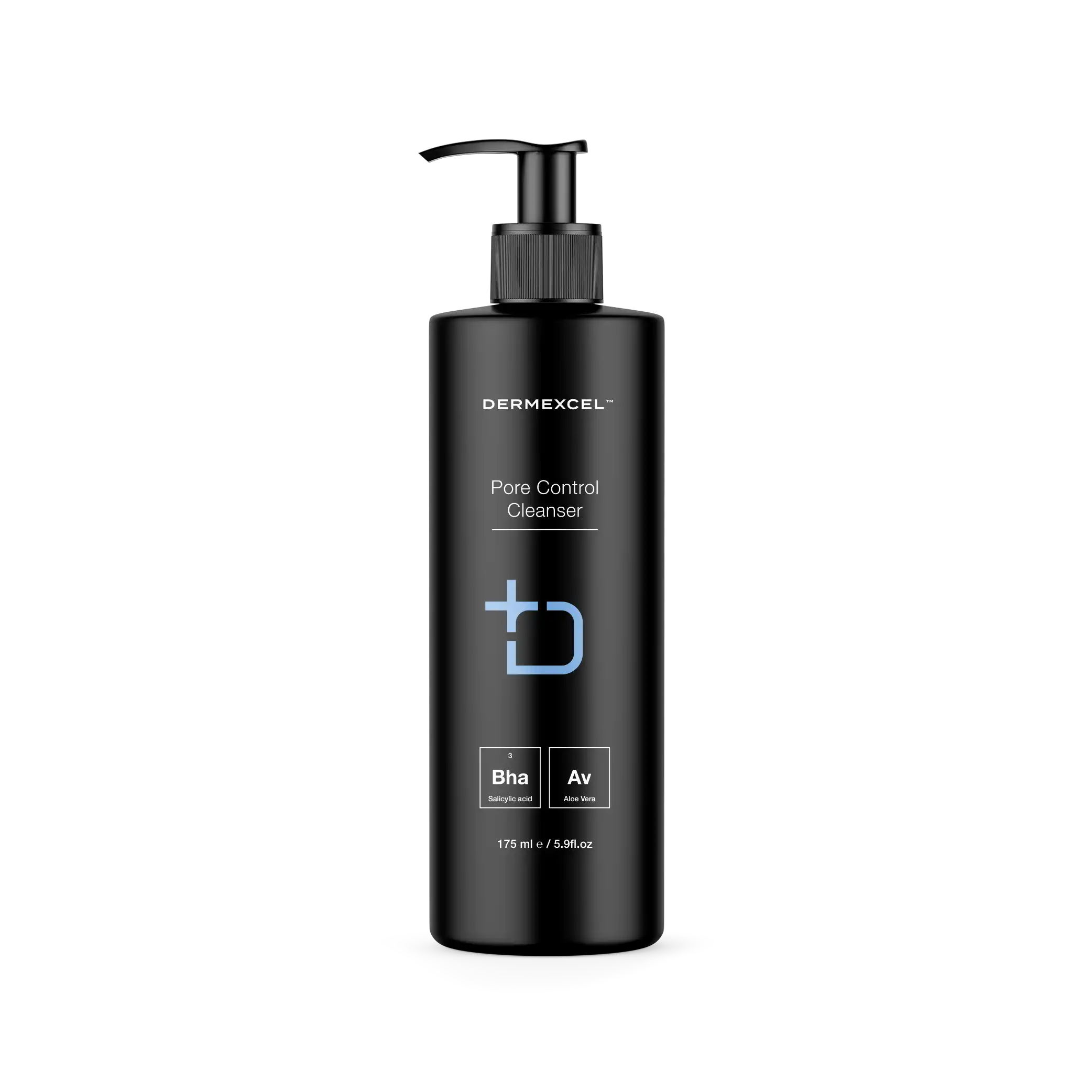
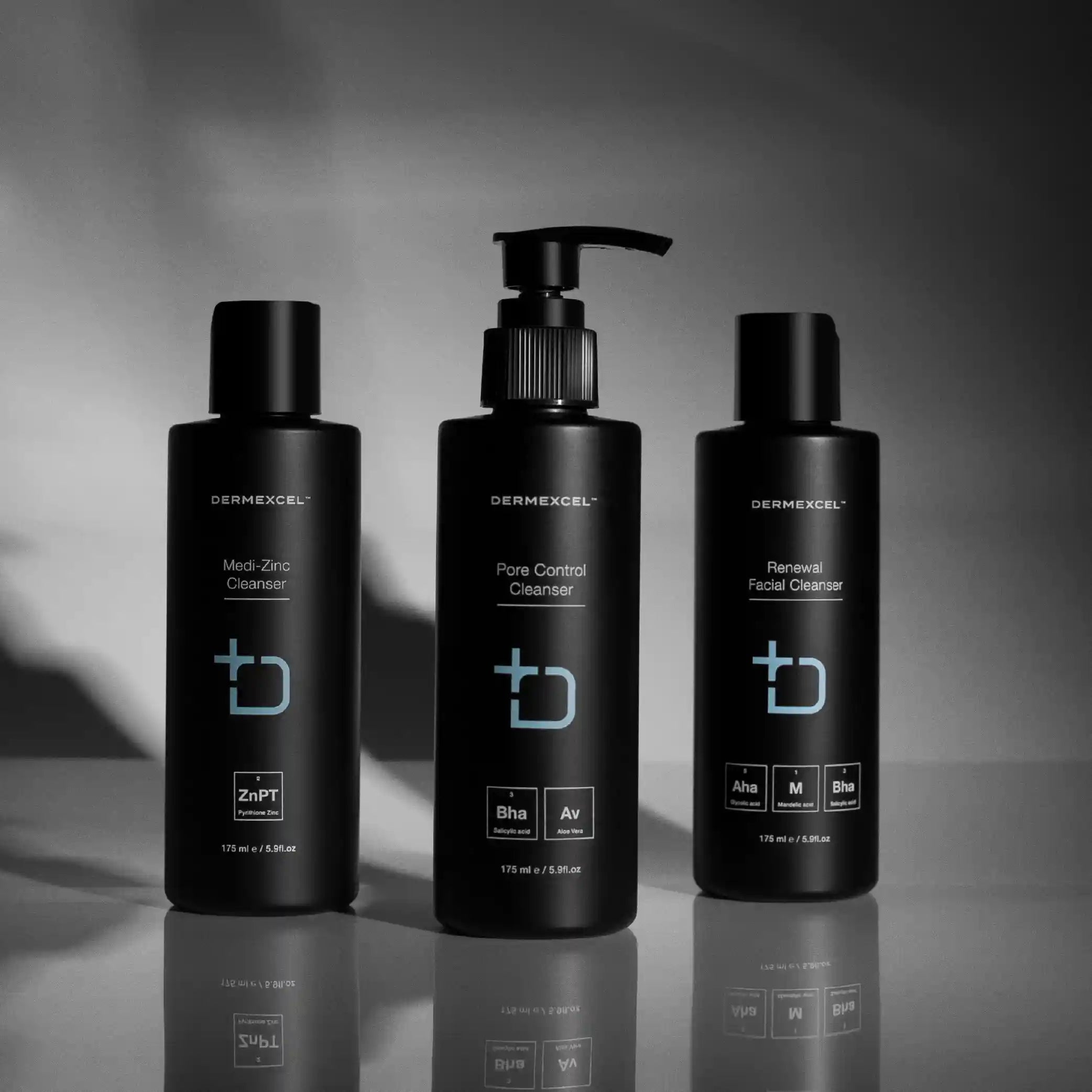
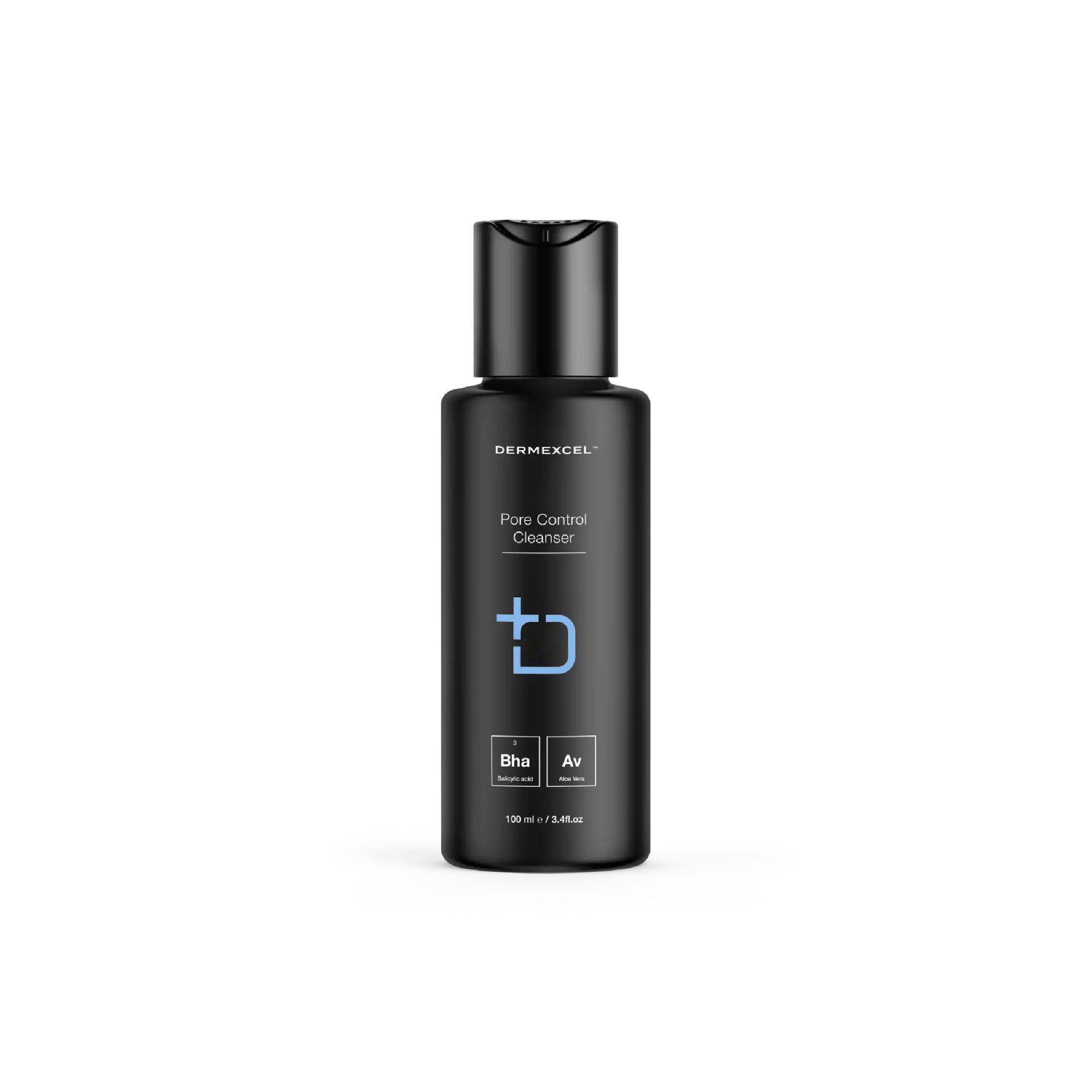





Unclog Pores

Minimize Pores

Anti-Acne

anti-redness

↓ inflammation
Scientifically formulated, this skincare solution regulates sebum production and alleviates pore congestion. With a 3% concentration of Salicylic acid, it reduces skin irritation and redness and effectively cleanses impurities. It also includes Medical-Grade Aloe Vera for soothing and hydrating effects, ideal for dehydrated skin from acne treatments.
Pore Control Cleanser is a balanced blend of ingredients that normalize oil production, dislodge sebum plugs, reduce inflammation, and nourish the skin, promoting a clear and healthy complexion.
Salicylic acid
Salicylic acid, a renowned beta hydroxy acid (BHA), is a cornerstone in dermatology and skincare due to its exceptional keratolytic and comedolytic properties. Its unique ability to penetrate oil-laden hair follicle pores makes it particularly effective in treating acne-prone and oily skin types.
Salicylic acid dissolves skin debris (sebum and dead skin cells) that clogs pores and causes acne. It's a mild antibacterial and powerful anti-inflammatory agent that helps reduce the redness and swelling associated with breakouts.
What sets salicylic acid apart in dermatological treatments is its ability to exfoliate the skin, not just on the surface but within the pores themselves. This is due to its oil-soluble nature, which allows it to penetrate deep into the pores and dissolve the keratin plugs that lead to blackheads and whiteheads.
Furthermore, salicylic acid also has the capacity to adjust the pH of the skin, creating an environment less favorable for the growth of acne-causing bacteria. Salicylic acid's efficacy in treating various skin conditions, particularly acne, has been extensively documented in the scientific literature. Studies have consistently shown its ability to reduce acne lesions in terms of count and severity. Additionally, salicylic acid is highly recommended for its effectiveness in treating other skin conditions, such as psoriasis and dandruff, due to its ability to soften and remove scales and flakes from the skin.
Physiological Effects
- Keratolytic Action: Salicylic acid is known for its ability to exfoliate the skin by dissolving the intercellular 'glue' that holds skin cells together, helping to remove dead skin cells and unclog pores.
- Comedolytic Effect: It is particularly effective in reducing comedones (blackheads and whiteheads) by unclogging pores and preventing the formation of new comedones.
- Anti-inflammatory Properties: Salicylic acid reduces inflammation, which is beneficial in treating acne and other inflammatory skin conditions.
- Sebum Regulation: It helps to regulate oil production, making it a valuable ingredient for managing oily and acne-prone skin.
- Penetration Enhancement: Due to its lipophilic nature, it can penetrate sebum-filled follicles, effectively treating acne located deep within the pores.
Managing Dermatological Conditions
- Acne Vulgaris: Salicylic acid is a cornerstone in acne treatment, effectively preventing and treating existing acne lesions.
- Psoriasis: Its keratolytic properties make it helpful in softening and removing scales associated with psoriasis.
- Warts: Salicylic acid is commonly used to treat warts because it can exfoliate and remove thick skin.
- Seborrheic Dermatitis: It helps manage seborrheic dermatitis by reducing scaling and redness.
- Keratosis Pilaris: Salicylic acid can aid in smoothing the rough bumps associated with peratosis Pilaris.
References
- Zaenglein, A. L., Pathy, A. L., Schlosser, B. J., Alikhan, A., Baldwin, H. E., Berson, D. S., & Thiboutot, D. M. (2016). Guidelines of care for the management of acne vulgaris. Journal of the American Academy of Dermatology, 74(5), 945-973.e33.
- Kornhauser, A., Coelho, S. G., & Hearing, V. J. (2010). Applications of hydroxy acids: classification, mechanisms, and photoactivity. Clinical, cosmetic and investigational dermatology, 3, 135.
- Zander, E., & Weisman, S. (1992). Treatment of acne vulgaris with salicylic acid pads. Clinical Therapeutics.
- Gupta, A. K., & Nicol, K. (2004). The use of sulfur in dermatology. Journal of Drugs in Dermatology.
Aloe Vera
Aloe vera is well-regarded for its medicinal applications and has been a staple in skincare and health for centuries. It’s rich in vitamins, enzymes, minerals, and amino acids, contributing to its many skin benefits.
Aloe vera contains polysaccharides, which are crucial in its moisturizing and anti-inflammatory properties. These polysaccharides help bind moisture to the skin, making aloe vera an excellent hydrating agent for dry and damaged skin.
One of the key benefits of aloe vera is its soothing and healing properties, particularly beneficial for burns, abrasions, and skin irritations. It has been shown to accelerate the healing of minor burns and reduce skin inflammation. Various studies have supported its effectiveness in treating first- and second-degree burns, highlighting its role in enhancing collagen synthesis and skin regeneration.
Aloe vera's anti-inflammatory properties are attributed to compounds like glycoproteins and polysaccharides. These compounds help reduce pain and swelling associated with skin irritations and wounds. Aloe vera also contains aloin and emodin, which provide analgesic, antibacterial, and antiviral properties, further extending its therapeutic potential.
Aloe Vera has numerous physiological effects on the skin due to its rich composition of vitamins, enzymes, minerals, and amino acids. The presence of antioxidants such as vitamins C and E, along with beta-carotene, contributes to its anti-aging benefits, helping to improve skin firmness and keep the skin hydrated.
Physiological Effects
- Moisturizing and Hydrating: Aloe Vera enhances skin hydration, making it effective for dry and dehydrated skin. Its mucopolysaccharides help to bind moisture into the skin.
- Wound Healing: It accelerates wound healing by enhancing collagen synthesis and cross-linking. This effect is particularly useful in healing burns, abrasions, and cuts.
- Anti-inflammatory Properties: Aloe Vera contains compounds like aloin and anthraquinones that have anti-inflammatory properties, making it beneficial in reducing skin inflammation.
- Antimicrobial Activity: It possesses antimicrobial properties, which help in preventing infections in wounds and burns.
- Antioxidant Properties: The presence of vitamins C and E and beta-carotene provides it with antioxidant properties, which can help protect the skin from free radical damage.
- Soothing Effect: Aloe Vera is known for its soothing effects on the skin, particularly in conditions like sunburn.
Managing Dermatological Conditions
- Burns and Wound Care: Aloe Vera's wound-healing and soothing properties make it effective in treating burns, including sunburns and minor skin abrasions.
- Acne Treatment: Due to its antimicrobial and anti-inflammatory properties, it can help treat acne.
- Eczema and Psoriasis: Its moisturizing, anti-inflammatory, and soothing properties are beneficial in managing symptoms of eczema and psoriasis.
- Aging Skin: Aloe Vera's antioxidant properties and ability to improve collagen production can help reduce the signs of aging.
- Skin Hydration: It's a common ingredient in moisturizers and other skin care products for its hydrating properties.
References
- Surjushe, A., Vasani, R., & Saple, D. G. (2008). Aloe vera: A short review. Indian Journal of Dermatology.
- Maenthaisong, R., Chaiyakunapruk, N., Niruntraporn, S., & Kongkaew, C. (2007). The efficacy of aloe vera used for burn wound healing: A systematic review. Burns.
- Rajeswari, R., Umadevi, M., Rahale, C. S., Pushpa, R., Selvavenkadesh, S., Kumar, K. S., & Bhowmik, D. (2012). Aloe vera: The miracle plant its medicinal and traditional uses in India. Journal of Pharmacognosy and Phytochemistry.







